.JPG.webp)
Road signs in Lithuania ensure that transport vehicles move safely and orderly, as well as to inform the participants of traffic built-in graphic icons. These icons are governed by the Vienna Convention on Road Traffic and Vienna Convention on Road Signs and Signals.[1]
Sign design is most similar to countries that comprised the now dissolved USSR with most of the signs having identical design. This includes neighboring Belarus and Russia. Neighboring post-Soviet Baltic countries Latvia and Estonia which were also part of Soviet Union have modified their road sign designs a little bit further than the road sign standard that was applied for the whole USSR before dissolution in the early 1990s.
Lithuanian road sign design saw minor changes in 2014. Some of the warning signs design were changed, a few new signs were added, like the sign indicating speed bump (formerly uneven road sign was used for indicating speed bumps), or sign indicating emergency stopping lane. Also, Lithuania is the only post-Soviet state to use both a blue and green background on the "Motorway" road sign. Lithuania formerly used only green background on the "Motorway" road sign, as do the rest of the post-Soviet states.
History
The first road signs arrived in Lithuania on October 1, 1930 after the President of the Republic Antanas Smetona signed the International Convention on automobile traffic.[2] In 1940, after the Soviet Union occupied and subsequently annexed Lithuania, the Soviet road traffic rules and road signs, which had been in force in the Soviet Union since 1936, were adopted in Lithuania. On January 1, 1980, the standard GOST 10807-78 (Russian: ГОСТ 10807-78) was adopted in the Soviet Union, including the territory of present-day Lithuania. In 1990, after Lithuania restored its independence by the Act of the Re-Establishment of the State of Lithuania and the dissoltion of the Soviet Union in 1991, the Soviet road sign design used remained unchanged.[3]
Due to the fact that modern road signs in Lithuania are very similar in design to Soviet signs, including modern Russian, Belarusian, Ukrainian, and Moldovan signs, there have been proposals to change the design of road signs used in Lithuania. In 2020, Seimas deputy Kęstutis Masiulis addressed the Minister of Transportation Jaroslavas Narkevičius with a proposal to change the design of road signs, which had not been changed since Soviet times.[4] He stated the following about it:
Lietuvos kelio ženklų dizainas per 30 laisvos Lietuvos metų mažai keitėsi ir yra beveik toks pat, kaip buvo naudojamas Sovietų Sąjungoje, o dabar vis dar yra naudojamas Rusijoje, Baltarusijoje, Ukrainoje, Moldovoje ir kitur. Taip simboliškai vis dar esame buvusios SSRS įtakos zonoje. Lenkijoje, Vokietijoje, Prancūzijoje ir kitose Vakarų Europos šalyse kelio ženklinimo dizainas pastebimai skiriasi nuo lietuviško. Jeigu jau esame Vakarų pasaulio dalis, kodėl vis dar išlaikome net ir simbolines sąsajas su SSRS?
The design of Lithuanian road signs has changed little in the 30 years of free Lithuania, and is almost identical to that used in the Soviet Union and still used in Russia, Belarus, Ukraine, Moldova and elsewhere. Symbolically, we are still in the zone of influence of the former USSR. In Poland, Germany, France and other Western European countries, the design of road markings is markedly different from that in Lithuania. If we are already part of the Western world, why do we still retain even symbolic links with the USSR?
— Kęstutis Masiulis
Warning signs
- 1. Warning signs
 Level crossing ahead, with gates
Level crossing ahead, with gates Level crossing ahead, without gates
Level crossing ahead, without gates Roadworks
Roadworks Swing bridge
Swing bridge Unprotected quayside or riverbank
Unprotected quayside or riverbank Children
Children Crossroads without priority (give way to the vehicles coming from the right)
Crossroads without priority (give way to the vehicles coming from the right) Junction with minor road
Junction with minor road Junction with minor road (from the right)
Junction with minor road (from the right) Junction with minor road (from the left)
Junction with minor road (from the left) Roundabout
Roundabout Traffic signals
Traffic signals Dangerous curve to the right
Dangerous curve to the right Dangerous curve to the left
Dangerous curve to the left Double curve, first to the right
Double curve, first to the right Double curve, first to the left
Double curve, first to the left Steep descent
Steep descent Steep ascent
Steep ascent Slippery road
Slippery road Uneven road
Uneven road Gravel loose
Gravel loose Dangerous shoulder
Dangerous shoulder Road narrow on both sides
Road narrow on both sides Road narrow on right side
Road narrow on right side Road narrow on left side
Road narrow on left side End of one-way traffic
End of one-way traffic Pedestrian crossing
Pedestrian crossing Pedestrians
Pedestrians Cyclists
Cyclists Cattle crossing
Cattle crossing Deer crossing
Deer crossing Falling rocks
Falling rocks Crosswinds
Crosswinds Low-flying aircraft
Low-flying aircraft Traffic jams
Traffic jams Accidents area
Accidents area Other dangers
Other dangers Level crossing (single track)
Level crossing (single track) Level crossing (multiple tracks)
Level crossing (multiple tracks) Level crossing countdown
Level crossing countdown Level crossing countdown
Level crossing countdown Level crossing countdown
Level crossing countdown Level crossing countdown
Level crossing countdown Level crossing countdown
Level crossing countdown Level crossing countdown
Level crossing countdown Chevron right
Chevron right Chevron left
Chevron left Curve to the (T)
Curve to the (T) Ruts ahead
Ruts ahead Speedbump
Speedbump
Priority signs
- 2. Priority signs
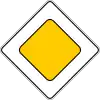 Priority road
Priority road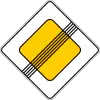 End of priority road
End of priority road Give way
Give way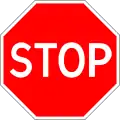 Stop
Stop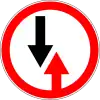 Give priority to oncoming traffic
Give priority to oncoming traffic Priority over oncoming traffic
Priority over oncoming traffic
Prohibitory signs
- 3. Prohibitory signs
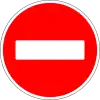 Do not enter
Do not enter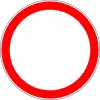 Closed to all vehicles in both directions
Closed to all vehicles in both directions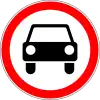 No motor vehicles except motorcycles
No motor vehicles except motorcycles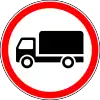 No trucks
No trucks No entry for motorcycles
No entry for motorcycles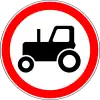 No tractors
No tractors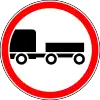 No trailers
No trailers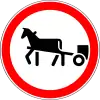 No animal-drawn vehicles
No animal-drawn vehicles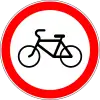 No cycles
No cycles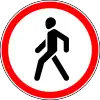 No pedestrians
No pedestrians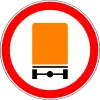 No vehicles carrying dangerous goods
No vehicles carrying dangerous goods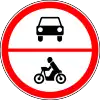 No power-driven vehicles
No power-driven vehicles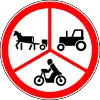 No power-driven or animal-drawn vehicles
No power-driven or animal-drawn vehicles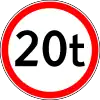 Mass limit
Mass limit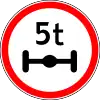 Total mass limit
Total mass limit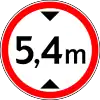 Height limit
Height limit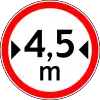 Width limit
Width limit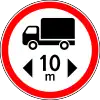 Length limit
Length limit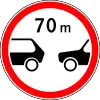 Minimum separation
Minimum separation Passing without stopping prohibited
Passing without stopping prohibited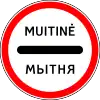 Passing without stopping prohibited
Passing without stopping prohibited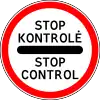 Passing without controlling prohibited
Passing without controlling prohibited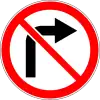 No right turn
No right turn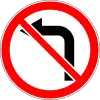 No left turn
No left turn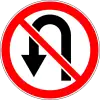 No U-turn
No U-turn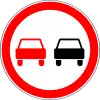 No overtaking
No overtaking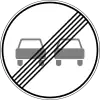 End of overtaking prohibition
End of overtaking prohibition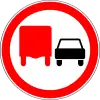 No overtaking by trucks
No overtaking by trucks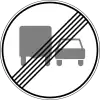 End of overtaking prohibition by trucks
End of overtaking prohibition by trucks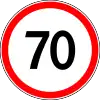 Maximum speed limit
Maximum speed limit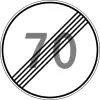 End of speed limit
End of speed limit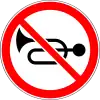 No audible warning devices
No audible warning devices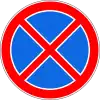 No stopping
No stopping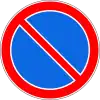 No parking
No parking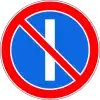 Alternate parking on odd days
Alternate parking on odd days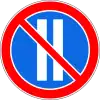 Alternate parking on even days
Alternate parking on even days End of all prohibitions
End of all prohibitions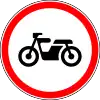 No mopeds
No mopeds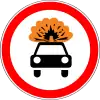 No vehicles carrying explosive or readily inflammable substances
No vehicles carrying explosive or readily inflammable substances No vehicles carrying substance liable to cause water pollution
No vehicles carrying substance liable to cause water pollution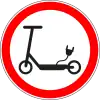 No motorized scooter
No motorized scooter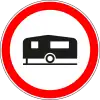 No residential vehicle
No residential vehicle
Mandatory signs
- 4. Mandatory signs
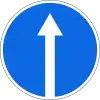 Proceed straight
Proceed straight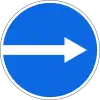 Turn right
Turn right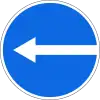 Turn left
Turn left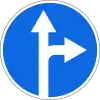 Straight ahead or right turn permitted
Straight ahead or right turn permitted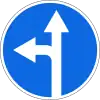 Straight ahead or left turn permitted
Straight ahead or left turn permitted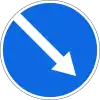 Keep right
Keep right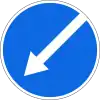 Keep left
Keep left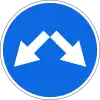 Keep left or right
Keep left or right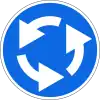 Roundabout
Roundabout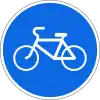 Cycle path
Cycle path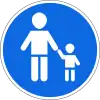 Pedestrian path
Pedestrian path Cycle and pedestrian path
Cycle and pedestrian path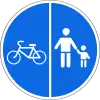 Cycle and pedestrian path
Cycle and pedestrian path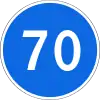 Minimum speed
Minimum speed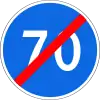 End of minimum speed
End of minimum speed Proceed straight for vehicles carrying dangerous goods
Proceed straight for vehicles carrying dangerous goods
Regulatory signs
- 5. Regulatory signs
 Dual motorway
Dual motorway End of dual motorway
End of dual motorway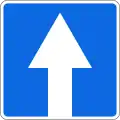 One-way street
One-way street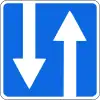 Two-way lanes
Two-way lanes One-way street to the right
One-way street to the right One-way street to the left
One-way street to the left Traffic directions at the intersection
Traffic directions at the intersection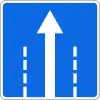 The direction of traffic at the intersection is straight
The direction of traffic at the intersection is straight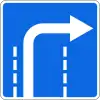 The direction of traffic at the intersection is to the right
The direction of traffic at the intersection is to the right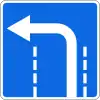 The direction of traffic at the intersection is left
The direction of traffic at the intersection is left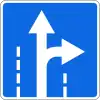 The direction of traffic at the intersection is straight and right
The direction of traffic at the intersection is straight and right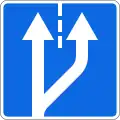 Added lane from right
Added lane from right Added lane from left
Added lane from left End of the right lane
End of the right lane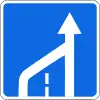 End of the left lane
End of the left lane Traffic directions in traffic lanes
Traffic directions in traffic lanes Traffic directions in traffic lanes
Traffic directions in traffic lanes Traffic directions in traffic lanes
Traffic directions in traffic lanes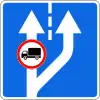 Lane start and limits
Lane start and limits Traffic in lanes
Traffic in lanes Added lane from junction
Added lane from junction Added lane from junction
Added lane from junction Lane reserved for buses
Lane reserved for buses Lane reserved for buses
Lane reserved for buses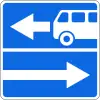 Entrance to the road with a lane for buses
Entrance to the road with a lane for buses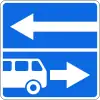 Entrance to the road with a lane for buses
Entrance to the road with a lane for buses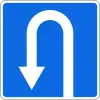 U-turn
U-turn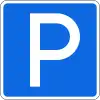 Parking
Parking Parking on limited duration only
Parking on limited duration only Parking on time period only
Parking on time period only Reserved parking only
Reserved parking only Parking of bus vehicle
Parking of bus vehicle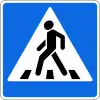 Pedestrian crossing
Pedestrian crossing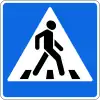 Pedestrian crossing
Pedestrian crossing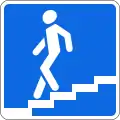 Underground pedestrian crossing
Underground pedestrian crossing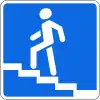 Footbridge
Footbridge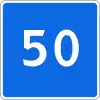 Advisory speed
Advisory speed No parking zone
No parking zone Parking zone
Parking zone Speed limit zone
Speed limit zone End of no parking zone
End of no parking zone End of parking zone
End of parking zone End of speed limit zone
End of speed limit zone Start of tunnel
Start of tunnel End of tunnel
End of tunnel Bus stop
Bus stop Taxi stop
Taxi stop Start of city limit
Start of city limit Start of city limit
Start of city limit Start of city limit
Start of city limit End of city limit
End of city limit End of city limit
End of city limit Residential area
Residential area End of city limit
End of city limit End of residential area
End of residential area Stop-line
Stop-line Motorway
Motorway End of motorway
End of motorway Safety island
Safety island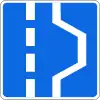 Emergency stopping lane
Emergency stopping lane Bicycle street
Bicycle street End of bicycle street
End of bicycle street
Information signs
- 6. Information signs
 Advance direction indicator
Advance direction indicator Advance direction indicator
Advance direction indicator Advance direction indicator
Advance direction indicator Advance direction indicator
Advance direction indicator Advance direction indicator
Advance direction indicator Advance direction indicator
Advance direction indicator Indication of direction
Indication of direction Indication of direction
Indication of direction Indication of direction
Indication of direction Indication of direction
Indication of direction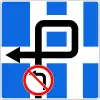 Driving scheme
Driving scheme Driving direction for trucks
Driving direction for trucks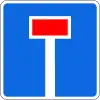 Dead end
Dead end Start of city
Start of city End of city
End of city River name
River name County name
County name Street name
Street name Street name
Street name Distance index
Distance index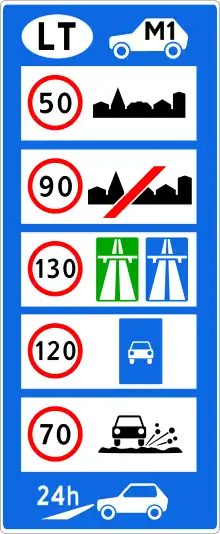 General speed limits
General speed limits Kilometer sign
Kilometer sign Kilometer sign
Kilometer sign International Road number
International Road number County Road number
County Road number Motorway number
Motorway number Number and direction of the road
Number and direction of the road Number and direction of the road
Number and direction of the road Number and direction of the road
Number and direction of the road Number and direction of the road or cycle track
Number and direction of the road or cycle track Number and direction of cycle track
Number and direction of cycle track Circuit diagram
Circuit diagram Detour direction
Detour direction Detour direction
Detour direction Reordering arrow
Reordering arrow Directional arrow to point of interest
Directional arrow to point of interest Name of the place to visit
Name of the place to visit Direction pointer to national, regional parks, state nature reserves, state nature and complex reserves
Direction pointer to national, regional parks, state nature reserves, state nature and complex reserves Beginning of a national, regional park, state nature reserve, state natural or complex reserve
Beginning of a national, regional park, state nature reserve, state natural or complex reserve End of national, regional park, state nature reserve, state natural or complex reserve
End of national, regional park, state nature reserve, state natural or complex reserve Direction to historical national, historical regional parks, state cultural reserves, museums
Direction to historical national, historical regional parks, state cultural reserves, museums Name of historical national, historical regional park, state cultural reserve, museum
Name of historical national, historical regional park, state cultural reserve, museum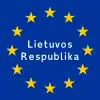 Republic of Lithuania EU sign
Republic of Lithuania EU sign Automatic traffic control
Automatic traffic control Automatic traffic control
Automatic traffic control
Service signs
- 7. Service signs
 First aid post
First aid post Hospital
Hospital Filling station
Filling station Breakdown service
Breakdown service Car washing
Car washing Public telephone
Public telephone Restaurant
Restaurant Refreshment
Refreshment Hotel
Hotel Camping site
Camping site Caravan site
Caravan site Caravan and camping site
Caravan and camping site Picnic site
Picnic site Police station
Police station Public lavatory
Public lavatory Swimming pool
Swimming pool Drinking water
Drinking water Customs area
Customs area Airport
Airport Information zone
Information zone Youth hostel
Youth hostel Rural tourism homestead
Rural tourism homestead National historic/cultural/tourist site
National historic/cultural/tourist site Fishing
Fishing Golf sport
Golf sport Equestrian sport
Equestrian sport Ski lift
Ski lift Bus station
Bus station Train station
Train station Vehicle ferry
Vehicle ferry Registry of vehicles or drivers
Registry of vehicles or drivers Technical inspection station
Technical inspection station Electric car charging place
Electric car charging place Industrial zone
Industrial zone
Additional panels
- 8. Additional panels
 Distance
Distance Side extension (of no stopping or no parking)
Side extension (of no stopping or no parking) Side extension (of no stopping or no parking)
Side extension (of no stopping or no parking)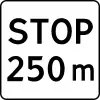 Stop ahead
Stop ahead Length
Length Beginning (of no stopping or no parking)
Beginning (of no stopping or no parking) Continuation (of no stopping or no parking)
Continuation (of no stopping or no parking) Ending (of no stopping or no parking)
Ending (of no stopping or no parking) Validity area to the right
Validity area to the right Validity area to the left
Validity area to the left Validity area in both directions
Validity area in both directions Direction of validity to the right
Direction of validity to the right Direction of validity to the left
Direction of validity to the left Direction of validity in both directions
Direction of validity in both directions Type of vehicle: Trucks
Type of vehicle: Trucks Type of vehicle: Vehicles with trailers
Type of vehicle: Vehicles with trailers Type of vehicle: Cars
Type of vehicle: Cars Type of vehicle: Buses
Type of vehicle: Buses Type of vehicles: Tractors
Type of vehicles: Tractors Type of vehicles: Motorcycles
Type of vehicles: Motorcycles Type of vehicles: Cycles
Type of vehicles: Cycles Saturdays, sundays and holidays
Saturdays, sundays and holidays Working days
Working days Days of the week
Days of the week Day of the week
Day of the week Time period
Time period Time period during saturdays, sundays and holidays
Time period during saturdays, sundays and holidays Time period during working days
Time period during working days Time period during days of the week
Time period during days of the week Parking method of vehicle
Parking method of vehicle Parking method of vehicle
Parking method of vehicle Parking method of vehicle
Parking method of vehicle Parking method of vehicle
Parking method of vehicle Parking method of vehicle
Parking method of vehicle Parking method of vehicle
Parking method of vehicle Parking method of vehicle
Parking method of vehicle Parking method of vehicle
Parking method of vehicle Parking method of vehicle
Parking method of vehicle Parking of no working engine only
Parking of no working engine only Payment services
Payment services Payment services during saturdays, sundays and holidays, working days, days of the week and time period
Payment services during saturdays, sundays and holidays, working days, days of the week and time period Dangerous roadside
Dangerous roadside Direction of priority road
Direction of priority road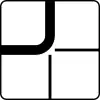 Direction of priority road
Direction of priority road Blind pedestrians
Blind pedestrians Wet coating
Wet coating Disabled parking
Disabled parking Except for the disabled
Except for the disabled Ice or snow
Ice or snow Compressed natural gas
Compressed natural gas Compressed natural gas
Compressed natural gas Liquified petroleum gas
Liquified petroleum gas Liquified petroleum gas
Liquified petroleum gas Types of fuel
Types of fuel Type of vehicle: Mopeds
Type of vehicle: Mopeds Except for cycles
Except for cycles Type of vehicle: Electric cars
Type of vehicle: Electric cars Except for electric cars
Except for electric cars Bicycle traffic
Bicycle traffic Type of vehicle: Residential vehicles
Type of vehicle: Residential vehicles
References
- ↑ Kelių eismo taisyklių 1 priedas – www.ketbilietai.lt
- ↑ Žičkus, Ričardas. "Įdomioji istorija: pirmieji kelio ženklai Lietuvoje, kai dar nereikėjo žalių rodyklių". 15min.lt/verslas (in Lithuanian). Retrieved 2023-11-03.
- ↑ "Konservatorius nerimsta: vėl kreipėsi į susisiekimo ministrą dėl "sovietinių kelio ženklų keitimo"". infa.lt (in Lithuanian). 2022-05-16. Retrieved 2023-11-03.
- ↑ "Konservatoriui nepatinka sovietinio dizaino kelio ženklai". Kauno diena (in Lithuanian). 2020-01-21. Retrieved 2024-01-09.